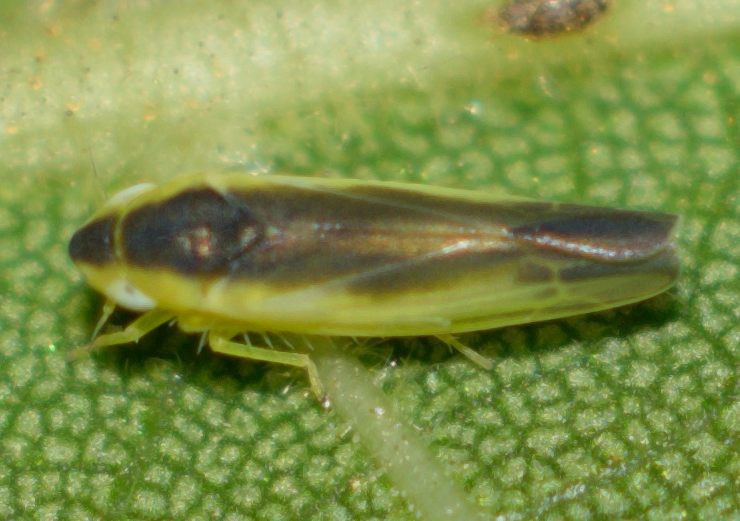| Comment: Erythridula is a very challenging genus to identify to species level, as there can be variation in pattern and coloration within species, and many species resemble one another. Dissecting specimens is the the only way to determine species for many cases. This page represents individuals that could represent one of several species that have a dark band on the wings and body: divisa, stolata, and rufostigmosa var. 'subnila'. C. Dietrich notes that he does not "know of any consistent way to tell members of this group apart using coloration." Therefore, it is not reliable to distinguish any individuals in this group to species level without analyzing a specimen or associating an individual with a host plant. Below are the descriptions from the 3I database, and links to those species profile pages, that show how similar these species can be to one another.
E. divisa- Dorsum yellow or white. Color pattern brown. Vertex with large basal dark area often extended onto pronotum. Vertex midline dark. Anteclypeus pale, concolorous with rest of face. Pronotum dark with pale lateral margins or pale with two longitudinal stripes. Mesonotum entirely dark, apex concolorous with rest of mesonotum. Thoracic venter with dark mesosternum, remainder pale. Forewings with oblique vittae, without crossbands. Clavus largely or entirely bright red or brown. Abdomen dark dorsally. Host plant: Juglans nigra.
E. rufostigmosa- Dorsum yellow or white. Color pattern red or orange or brown. Vertex with oblique lateral vittae or with large basal dark area often extended onto pronotum. Vertex midline pale or dark. Anteclypeus pale, concolorous with rest of face. Pronotum dark with pale lateral margins or pale with two longitudinal stripes. Mesonotum entirely dark, apex concolorous with rest of mesonotum. Thoracic venter with dark mesosternum, remainder pale. Forewings without oblique vittae or with oblique vittae or with oblique vittae usully forming continuous zigzag pattern, without crossbands. Clavus with continuous vitta parallel to suture or largely or entirely bright red or brown. Abdomen dark dorsally. Host plant: Salix spp.
E. stolata- Dorsum yellow or white. Color pattern red or orange or brown. Vertex with large basal dark area often extended onto pronotum. Vertex midline dark. Anteclypeus pale, concolorous with rest of face. Pronotum dark with pale lateral margins or pale with two longitudinal stripes. Mesonotum entirely dark, apex concolorous with rest of mesonotum. Thoracic venter entirely pale. Forewings without oblique vittae or with oblique vittae, without crossbands. Clavus largely or entirely bright red or brown. Abdomen dark dorsally. Host plant: Fagus grandifolia. |

 »
»


 »
»
